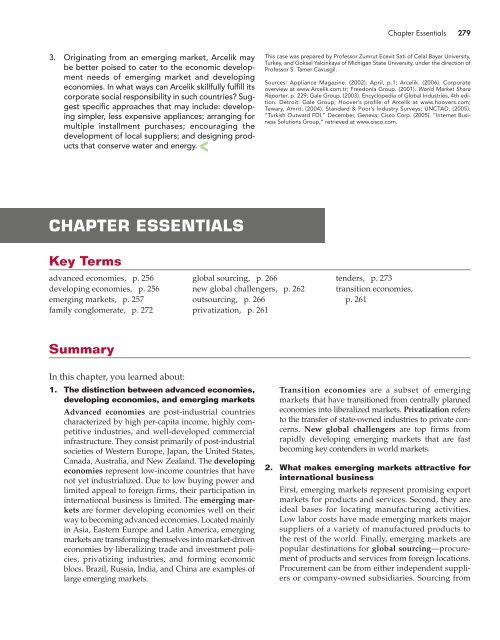Understanding Emerging Markets
Understanding Emerging Markets
Understanding Emerging Markets
Create successful ePaper yourself
Turn your PDF publications into a flip-book with our unique Google optimized e-Paper software.
CAVUMC09_254-283hr 10/15/07 11:23 AM Page 279<br />
Chapter Essentials 279<br />
3. Originating from an emerging market, Arcelik may<br />
be better poised to cater to the economic development<br />
needs of emerging market and developing<br />
economies. In what ways can Arcelik skillfully fulfill its<br />
corporate social responsibility in such countries? Suggest<br />
specific approaches that may include: developing<br />
simpler, less expensive appliances; arranging for<br />
multiple installment purchases; encouraging the<br />
development of local suppliers; and designing products<br />
that conserve water and energy. <<br />
This case was prepared by Professor Zumrut Ecevit Sati of Celal Bayar University,<br />
Turkey, and Goksel Yalcinkaya of Michigan State University, under the direction of<br />
Professor S. Tamer Cavusgil.<br />
Sources: Appliance Magazine. (2002). April, p.1; Arcelik. (2006). Corporate<br />
overview at www.Arcelik.com.tr; Freedonia Group. (2001). World Market Share<br />
Reporter, p. 229; Gale Group. (2003). Encyclopedia of Global Industries, 4th edition.<br />
Detroit: Gale Group; Hoover’s profile of Arcelik at www.hoovers.com;<br />
Tewary, Amrit. (2004). Standard & Poor’s Industry Surveys; UNCTAD. (2005).<br />
“Turkish Outward FDI.” December, Geneva; Cisco Corp. (2005). “Internet Business<br />
Solutions Group,” retrieved at www.cisco.com.<br />
CHAPTER ESSENTIALS<br />
Key Terms<br />
advanced economies, p. 256<br />
developing economies, p. 256<br />
emerging markets, p. 257<br />
family conglomerate, p. 272<br />
global sourcing, p. 266<br />
new global challengers, p. 262<br />
outsourcing, p. 266<br />
privatization, p. 261<br />
tenders, p. 273<br />
transition economies,<br />
p. 261<br />
Summary<br />
In this chapter, you learned about:<br />
1. The distinction between advanced economies,<br />
developing economies, and emerging markets<br />
Advanced economies are post-industrial countries<br />
characterized by high per-capita income, highly competitive<br />
industries, and well-developed commercial<br />
infrastructure. They consist primarily of post-industrial<br />
societies of Western Europe, Japan, the United States,<br />
Canada, Australia, and New Zealand. The developing<br />
economies represent low-income countries that have<br />
not yet industrialized. Due to low buying power and<br />
limited appeal to foreign firms, their participation in<br />
international business is limited. The emerging markets<br />
are former developing economies well on their<br />
way to becoming advanced economies. Located mainly<br />
in Asia, Eastern Europe and Latin America, emerging<br />
markets are transforming themselves into market-driven<br />
economies by liberalizing trade and investment policies,<br />
privatizing industries, and forming economic<br />
blocs. Brazil, Russia, India, and China are examples of<br />
large emerging markets.<br />
Transition economies are a subset of emerging<br />
markets that have transitioned from centrally planned<br />
economies into liberalized markets. Privatization refers<br />
to the transfer of state-owned industries to private concerns.<br />
New global challengers are top firms from<br />
rapidly developing emerging markets that are fast<br />
becoming key contenders in world markets.<br />
2. What makes emerging markets attractive for<br />
international business<br />
First, emerging markets represent promising export<br />
markets for products and services. Second, they are<br />
ideal bases for locating manufacturing activities.<br />
Low labor costs have made emerging markets major<br />
suppliers of a variety of manufactured products to<br />
the rest of the world. Finally, emerging markets are<br />
popular destinations for global sourcing—procurement<br />
of products and services from foreign locations.<br />
Procurement can be from either independent suppliers<br />
or company-owned subsidiaries. Sourcing from

















